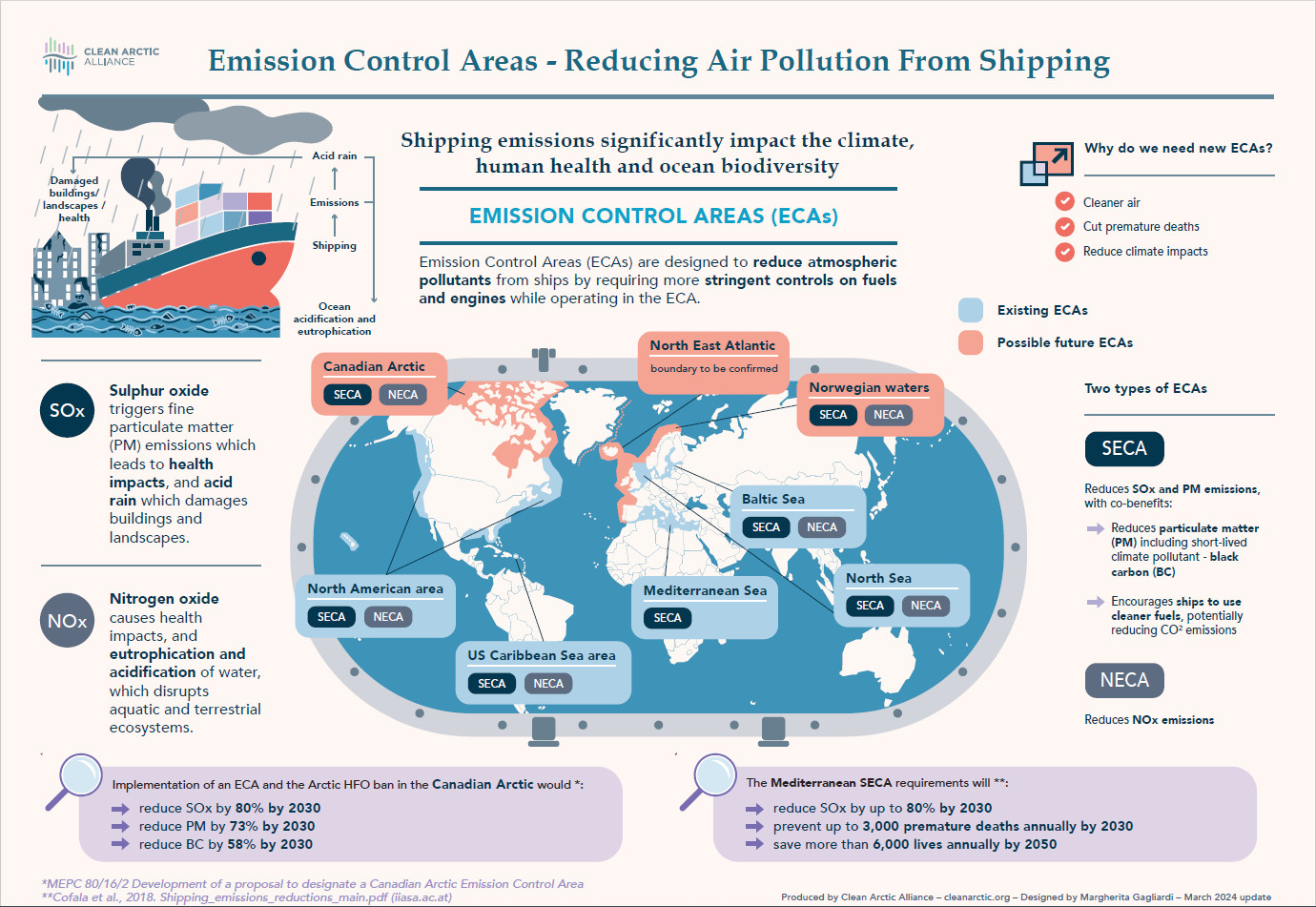Spotlight On The New Emission Control Area In Canadian Arctic Waters
20
The benefits of establishing an Emission Control Area (ECA) in Canadian Arctic waters support measures that would not only diminish harmful air emissions from ships, leading to improved air quality for northern communities, but also yield positive outcomes for marine and terrestrial ecosystems and wildlife. Furthermore, it would play a role in mitigating climate-forcing black carbon pollution in the Arctic. The recently announced ECAs in Canadian Arctic waters is poised to make substantial strides in reducing ship-related air pollution in the Arctic region.

The Emission Control Areas (ECAs) proposed by Canada and Norway, sanctioned by member states of the International Maritime Organisation (IMO), will bolster environmental safeguards in Canadian Arctic waters and the Norwegian Sea. These measures aim to curtail emissions of sulphur oxides (SOx), particulate matter, and nitrogen oxides (NOx) stemming from international shipping activities.
“The creation of Emission Control Areas in the Arctic will set an important precedent for protection of our climate and our ocean,” said Sian Prior, Lead Advisor to the Clean Arctic Alliance. “The proposal for a Canadian Arctic waters ECA includes a welcome and clear reference to the fact that the use of scrubbers as an alternative compliance mechanism will not provide the same benefits in terms of reducing black carbon emissions. Black carbon constitutes 20% of the shipping sector’s global climate impact, and it is five times more potent a climate disruptor when emitted in the Arctic region from sources such as shipping,” Prior concluded.
“The creation of these two new Emission Control Areas will set an important precedent for protection of our climate and our ocean, and particularly the Arctic”, said Dr Sian Prior, Lead Advisor to the Clean Arctic Alliance. “We hope that the designation of ECAs in Canadian Arctic Waters and the Norwegian Sea will drive broad positive change on reducing shipping climate pollutants, especially if the shipping sector complies with the designation by switching to low-sulphur distillate fuels or other cleaner non-fossil fuels. In addition, moving to cleaner fuels will reduce emissions of SOx and particulate matter leading to co-benefits with reductions in black carbon (BC) emissions, provided that cleaner ECA-compliant fuels – and, in particular, distillates – are used."
“The creation of an ECA in Canadian Arctic waters will reduce polluting air emissions from ships, improve air quality for northern populations, deliver benefits to both marine and terrestrial habitats and wildlife and also contribute to a reduction in climate-forcing black carbon pollution in the Arctic”, continued Prior. “The Norwegian Sea ECA will reduce impacts on human health and contribute to reduced deposition of nitrogen and sulphur along the Norwegian coast, including a 58% reduction in particulate matter, such as black carbon, by 2030 compared with 2020. Both ECAs will significantly reduce air pollution from ships in the Arctic.”
“The designation of ECAs in the Canadian Arctic waters and the Norwegian Sea highlights the need for continued work on a possible creation of an ECA in the North-East Atlantic Ocean as referred to at MEPC 80 last summer”, said Carolina Silva, Shipping & Ocean Policy Officer at Zero. “These ECAs will significantly expand the socio-economic, environmental and health benefits for a large number of coastal communities, as well as marine and coastal habitats and wildlife along the North-East Atlantic region, and will also have the co-benefit of reducing black carbon emissions from shipping further south which can still impact the Arctic.”
“ECAs remain one of the most efficient tools at IMO Member States’ disposal to tackle air pollution from ships and are particularly relevant for sensitive ecosystems like the Arctic, therefore, it is important that proposals for new ECAs are as effective and environmentally sound as possible, to ensure their full potential is realised”, continued Silva. “To this end, the positive show of support for Norway’s proposal, which rectifies a problem in the existing ECA regulations whereby a loophole allows ships to delay the implementation of the most stringent NOx reduction requirements, is a good first step in the right direction. Now the IMO must urgently address the fundamental shortcomings of the NOx regulation to prevent further delay of the most stringent requirements in other regions, and to maximise the potential emissions reductions from establishing new ECAs.”
#protea #emissions #monitoring #cems #ftir #gas #analysers #shipping #marine #carbon #capture
Other Articles
Carbon Capture Utilisation & Storage (CCUS) In 2026
16
Global Underground CO2 Storage Data Offers Hope Amid Rising Emissions
01
IMO Postpones Adoption Of Global Net-Zero Shipping Framework
04
Pioneering Carbon Capture Projects Ready For Construction
03
Methanol & Ammonia Deemed Ready As Zero-Emission Shipping Fuels
01
Carbon Capture Storage Reaching A Turning Point In Decarbonisation
13
CCS To Capture 15% Of Shipboard Carbon Emissions By 2050
29
Global Shipping Industry Struggles To Navigate Net Zero Transition
21
Carbon Capture Surges as Economics Policy & Industry Demand Align
14
GHG Emissions At Ports On The Rise Despite Initiatives
07